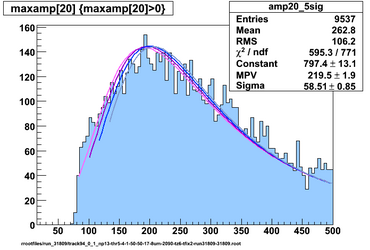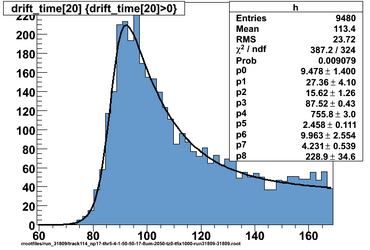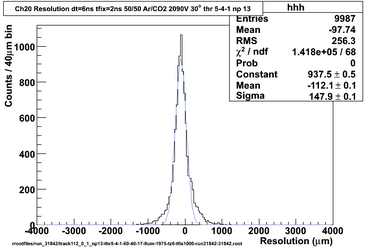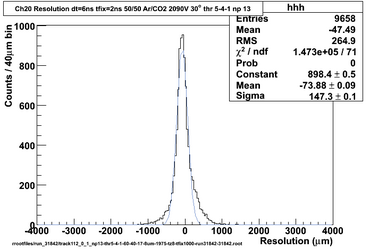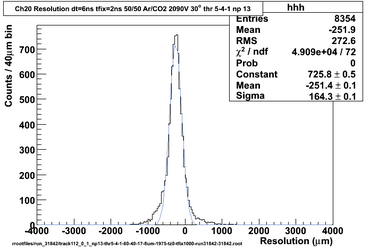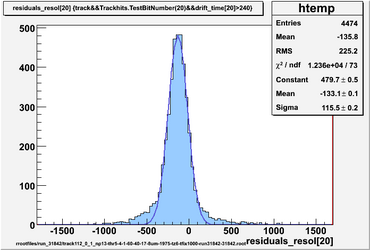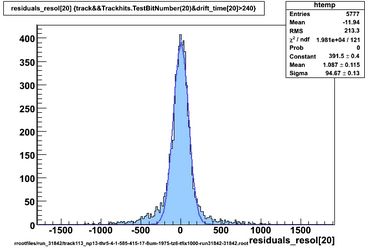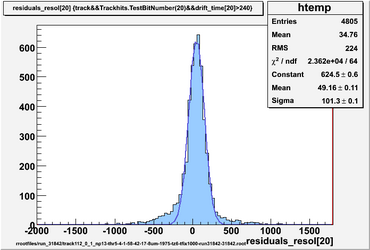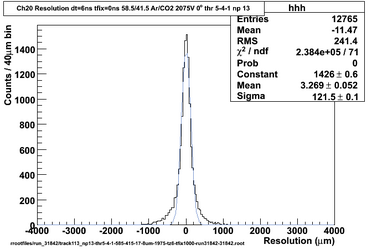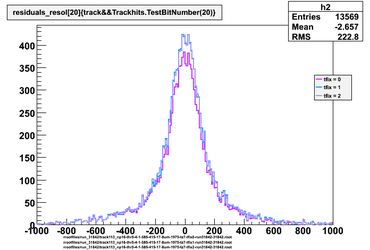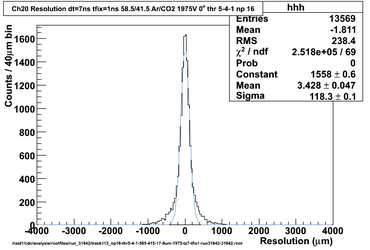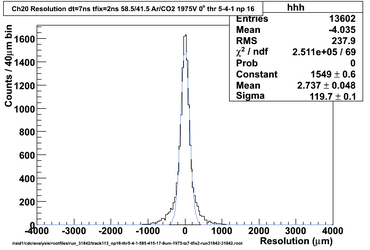|
|
| Line 114: |
Line 114: |
| | | | |
| | {| border="0" cellpadding="2" | | {| border="0" cellpadding="2" |
| − | |+ Drift time for 1975V, hit thresholds 5sigma, timing thresholds 4sigma, 1sigma, pedestal at t(t4sig)-17, tz_add=0 | + | |+ Drift time for 2090V, hit thresholds 5sigma, timing thresholds 4sigma, 1sigma, pedestal at t(t4sig)-17, tz_add=0 |
| | |[[Image:run_31809_np17_thr5_20.png|thumb|x350px|2090V, hit threshold 5sigma, time thresholds 4 and 1 sigma | | |[[Image:run_31809_np17_thr5_20.png|thumb|x350px|2090V, hit threshold 5sigma, time thresholds 4 and 1 sigma |
| | Estimate of t0 is 88 and tmax is 756, difference is 668, straight-line intercept is 79.2, to match histogram fit t0, use tz_add 8.4 | | Estimate of t0 is 88 and tmax is 756, difference is 668, straight-line intercept is 79.2, to match histogram fit t0, use tz_add 8.4 |
Revision as of 14:56, 12 October 2012
The later part of this page is 60/40 being used as a template for the 50/50. New stuff (50/50) is above the line.
50/50 Ar/CO2 and cosmics, prototype horizontal
2050V, 50/50 gas, prototype horizontal
 Pedestal mean of samples 0-99, ch20, over 1 day |
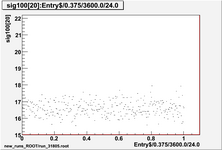 Pedestal std. dev. of samples 0-99, ch20, over 1 day |
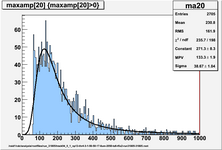 Max amplitude ch20, hit threshold 4sigma |
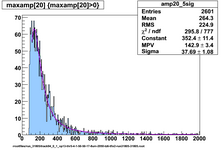 Max amplitude ch20, hit threshold 5sigma |
2075V, 50/50 gas, prototype horizontal
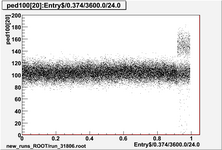 Pedestal mean of samples 0-99, ch20, over 1 day |
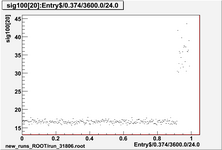 Pedestal std. dev. of samples 0-99, ch20, over 1 day |
 Max amplitude ch20, hit threshold 4sigma, excluding last 7k events |
 Max amplitude ch20, hit threshold 5sigma, excluding last 7k events |
2100V, 50/50 gas, prototype horizontal
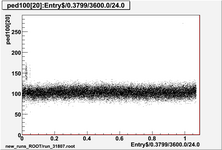 Pedestal mean of samples 0-99, ch20, over 1 day |
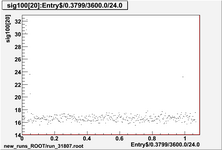 Pedestal std. dev. of samples 0-99, ch20, over 1 day |
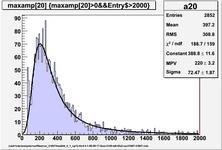 Max amplitude ch20, hit threshold 4sigma, excluding first 2k events |
 Max amplitude ch20, hit threshold 5sigma, excluding first 2k events |
2090V, 50/50 gas, prototype horizontal
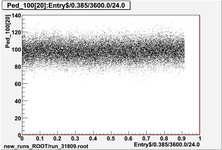 Pedestal mean of samples 0-99, ch20, over 1 day |
 Pedestal std. dev. of samples 0-99, ch20, over 1 day |
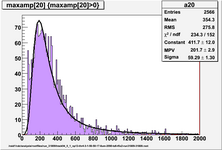 Max amplitude ch20, hit threshold 4sigma |
 Max amplitude ch20, hit threshold 5sigma |
Where to start the fit from.
50/50 gas, prototype horizontal, 4sigma (gray) and 5sigma (blue) hit threshold, fit range 6sigma+
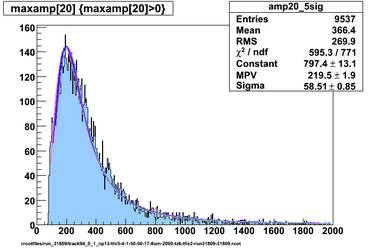 2090V, Landau fits, log likelihood method, fit range starting at 5, 6, 7, 8 x pedestal sigma |
|
The fits started at higher amplitude underestimate the width. Fit range starting at 5pedestalsigma has MPV 204.5, Sigma 61.9, MPV/Sigma 3.3.
Fit range starting at 6pedestalsigma has MPV 208.6, Sigma 60.7, MPV/Sigma 3.4.
Fit range starting at 7pedestalsigma has MPV 213.7, Sigma 59.5, MPV/Sigma 3.6.
Use 5pedestalsigma start.
50/50 gas, prototype horizontal, 4sigma (gray) and 5sigma (blue) hit threshold, fit range 5sigma+
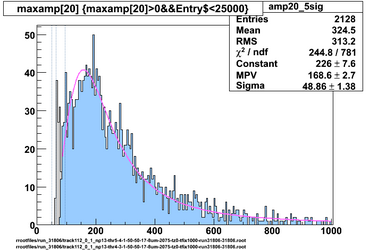 2075V, lines show 99.7%, 99% and 95% of landau summed 0-4000 (51, 66, 95) |
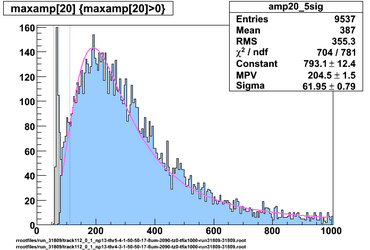 2090V, lines show 99.7%, 99% and 95% of landau summed 0-4000 (55, 74, 111) |
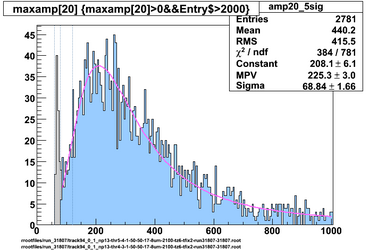 2100V, lines show 99.7%, 99% and 95% of landau summed 0-4000 (59, 80, 121) |
50/50 gas, noise std dev 16.5, hit threshold 5x16.5 = 82.5
| HV
|
Fit MPV
|
Fit sigma (FWHM/4)
|
Fit 4sigma/MPV
|
MPV/sigma
|
4045/MPV
|
99% point
|
97% point
|
95% point
|
| 2075
|
169
|
49
|
1.16
|
3.5
|
24
|
66
|
84
|
95
|
| 2090
|
204
|
62
|
1.21
|
3.3
|
20
|
74
|
97
|
111
|
| 2100
|
225
|
69
|
1.22
|
3.3
|
18
|
80
|
106
|
122
|
Find out where to take local pedestal. These are plots of change in ADC value vs time relative to the threshold crossing time.
Nothing to do with Garfield or tz_add but already have a good default in place (take pedestal at np=13 minisamples before threshold crossing) so small changes here are a fine tuning.
2090V 50/50 Change in ADC value vs time relative to the threshold crossing time (in units of 8ns/5)
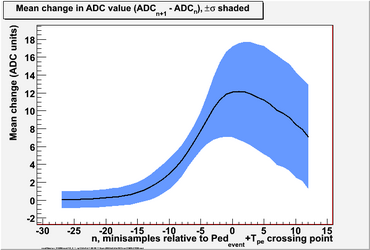 2090V, hit thr 5 ped-sigma |
Mean goes through 0.5 and 1 at -17.2 and -14.4 for thr=5sigma
Drift time for 2090V, hit thresholds 5sigma, timing thresholds 4sigma, 1sigma, pedestal at t(t4sig)-17, tz_add=0
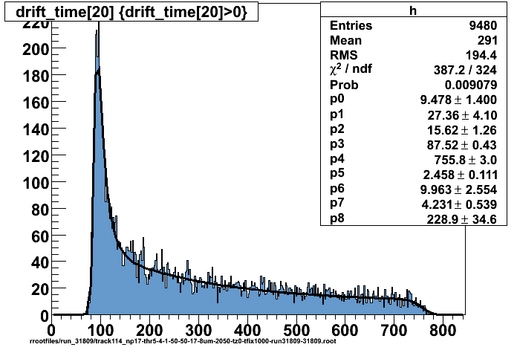 2090V, hit threshold 5sigma, time thresholds 4 and 1 sigma Estimate of t0 is 88 and tmax is 756, difference is 668, straight-line intercept is 79.2, to match histogram fit t0, use tz_add 8.4 |
|
The later part of this page is 60/40 being used as a template for the 50/50. New stuff (50/50) is above the line.
Resolution for 1975V, hit thresholds 5sigma, timing thresholds 4sigma, 1sigma, pedestal at t(t4sig)-13, tz_add=6, 60/40 Garfield
(ignore the title saying 50/50, I forgot to change that part of the root script)
|
|
 1975V, resolution vs hit radius |
This does not look nearly as good as 50/50 gas mix.
Resolution is calculated as fitted drift distance - measured (interpolated) distance, so it is positive when the measured drift time and distance are too small.
In this case they are slightly too small at small drift distance but too large at large drift distance. This could be a problem with the gas mix. For reference, plot res vs distance for tz=5,7,and 0.
Resolution for 1975V, hit thresholds 5sigma, timing thresholds 4sigma, 1sigma, pedestal at t(t4sig)-13, tz_add=8, 60/40 Garfield
|
|
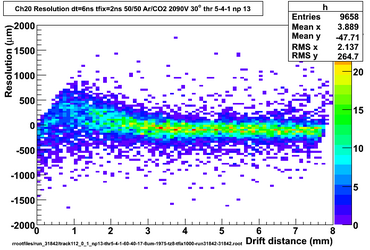 1975V, resolution vs hit radius |
Increasing tz_add to 8ns shifts the resolution up at earlier times but it hardly moves at later times. This would probably have been obvious from the tz=0 data (below) where all the measured drift distances are too large. "Measured" drift distances are actually interpolated from a table of distance calculated for a given gas mix and a range of time measurements. So for this data I should use Garfield tables for a gas mix with slower drift velocity, ie less Ar.
Resolution for 1975V, hit thresholds 5sigma, timing thresholds 4sigma, 1sigma, pedestal at t(t4sig)-13, tz_add=0, 60/40 Garfield
|
|
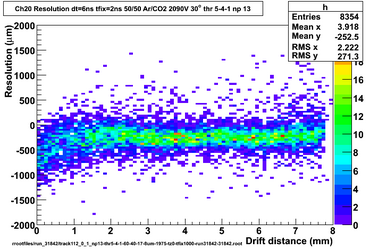 1975V, resolution vs hit radius |
Suspect total flow of 60sccm might be too low for the CO2 MFC. Increase to 80sccm and repeat. Also try Garfield for different gas mixes and look at tmax.
Fitted Tmax was 573, edge is from 560 to 600ns. Garfield calcs give 560ns for 60/40, 573ns (ta-daa!) for 59/41, 588ns for 28/42 and 610ns for 57/43.
It's easiest to look at resolution far from the wire to find the best gas mix model.
Resolution for 1975V, drift time > 240ns (~approx 5mm), different gas mix in Garfield, same thresholds and pedestal as before, tz_add=6ns
|
|
|
|
|
Resolution for 1975V, same thresholds and pedestal as before, tz_add=6ns, 58.5/41.5 Garfield
|
|
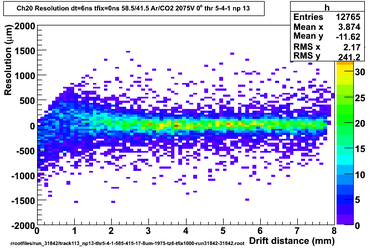 1975V, resolution vs hit radius |
Now look at timing. Where to take local pedestal. These are plots of change in ADC value vs time relative to the threshold crossing time.
Nothing to do with Garfield or tz_add but already have a good default in place (take pedestal at np=13 minisamples before threshold crossing) so small changes here are a fine tuning.
1975V 59/41 Garfield etc Change in ADC value vs time relative to the threshold crossing time (in units of 8ns/5)
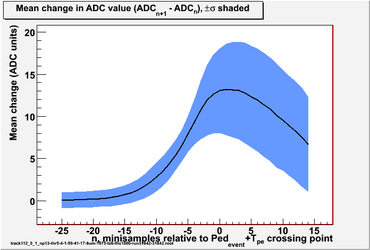 1975V, hit thr 5 ped-sigma |
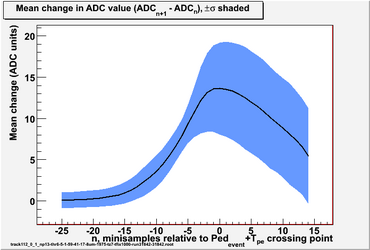 1975V, hit thr 6 ped-sigma |
Mean goes through 0.5 and 1 at -16.4 and -13.7 for thr=5sigma, -17.6 and -14.9 for thr=6sigma
1975V 58.5/41.5 Garfield etc Resolution for different local pedestal points, tz_add=6ns
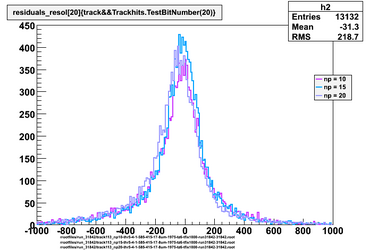 10, 15, and 20 points (1.6ns each) before hit threshold |
 15, 16, and 17 points (1.6ns each) before hit threshold |
1975V 58.5/41.5 Garfield etc Resolution for different local pedestal points, tz_add=7ns
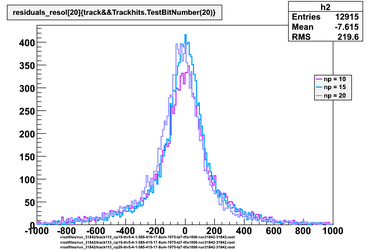 10, 15, and 20 points (1.6ns each) before hit threshold |
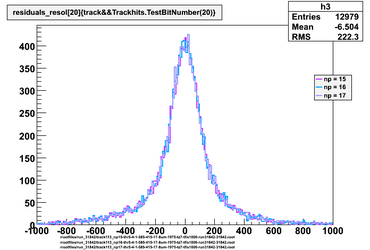 15, 16, and 17 points (1.6ns each) before hit threshold |
Resolution for 1975V, 58.5/41.5 Garfield, hit thresholds 5sigma, timing thresholds 4sigma, 1sigma, pedestal at t(t4sig)-16, tz_add=7ns, tfix=1000
|
|
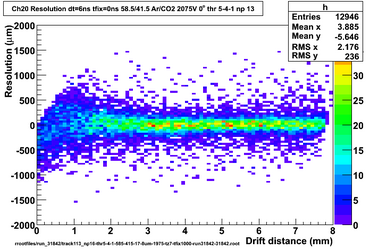 1975V, resolution vs hit radius |
Now include previously ignored hits which arrived before tzero+tz_add, assign these to a fixed drift time
1975V 58.5/41.5 Garfield etc Resolution for np=16, tz_add=7ns, early hits assigned to 0ns, 1ns, 2ns
|
|
Resolution for 1975V, 58.5/41.5 Garfield, hit thresholds 5sigma, timing thresholds 4sigma, 1sigma, pedestal at t(t4sig)-16, tz_add=7ns, tfix=1ns
|
|
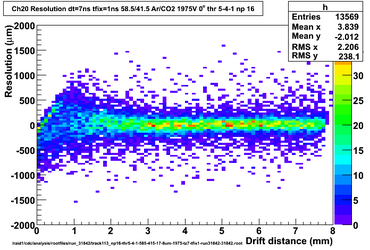 1975V, resolution vs hit radius |
Resolution for 1975V, 58.5/41.5 Garfield, hit thresholds 5sigma, timing thresholds 4sigma, 1sigma, pedestal at t(t4sig)-16, tz_add=7ns, tfix=2ns
|
|
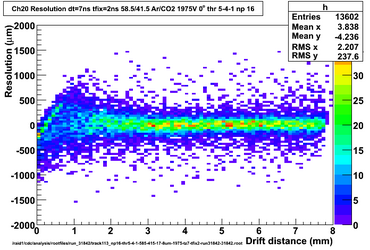 1975V, resolution vs hit radius |

















